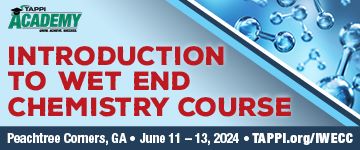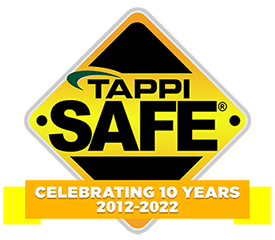 Search
Search
Use the search bar or filters below to find any TAPPI product or publication.
Filters
Content Type
Publications
Level of Knowledge
Collections
Magazine articles

Nonchlorine bleaching conference: the future is here, TAPPI JOURNAL, July 1992, Vol. 75(7)
Nonchlorine bleaching conference: the future is here, TAPPI JOURNAL, July 1992, Vol. 75(7)
Magazine articles

Forklift emissions - some solutions, TAPPI JOURNAL, December 1993, Vol. 76(12)
Forklift emissions - some solutions, TAPPI JOURNAL, December 1993, Vol. 76(12)
Magazine articles

Influence of tube metallurgy on corrosion resistance of liquor heaters, TAPPI JOURNAL, March 1991, Vol. 74(3)
Influence of tube metallurgy on corrosion resistance of liquor heaters, TAPPI JOURNAL, March 1991, Vol. 74(3)
Magazine articles

Hydrogen peroxide: innovations in chemical pulp bleaching, TAPPI JOURNAL, January 1991, Vol. 74(1)
Hydrogen peroxide: innovations in chemical pulp bleaching, TAPPI JOURNAL, January 1991, Vol. 74(1)
Magazine articles

Measuring customer perception of print quality, TAPPI JOURNAL, March 1990, Vol. 73(3)
Measuring customer perception of print quality, TAPPI JOURNAL, March 1990, Vol. 73(3)
Journal articles

Magazine articles

Wheat straw as an alternative pulp fiber, TAPPI Journal January 2020
ABSTRACT: The desire to market sustainable packaging materials has led to an interest in the use of various fiber types as a raw material. It has been suggested that the use of annual crops for partial replacement of wood fiber would result in more sustainable products. Several life cycle analyses (LCA) have been performed to evaluate these claims. These LCAs provided conflicting and contradictory results because of the local conditions and the specific pulping processes investigated. Selected LCAs are reviewed and the underlying reasons for these conflicting results are analyzed.
Journal articles

Magazine articles

Effect of high sulfate content on viscosity of recovery boiler molten smelt, TAPPI Journal March 2024
ABSTRACT: A systematic study was conducted to examine the effect of high sulfate content on the freezing temperature of molten smelt and how this may contribute to the formation of viscous jellyroll smelt in recovery boilers. The results show that even for recovery boilers with a smelt reduction as low as 70%, the sulfate content in smelt has no or little effect on smelt freezing temperature, and hence, on molten smelt fluidity. The perceived adverse effect of high sulfate content on smelt fluidity and on jellyroll smelt formation comes from the high sulfate content in deposits that have fallen from the upper furnace. Fallen deposits may or may not form jellyroll smelt, depending on whether or not they can melt and be well-mixed with molten smelt by the time they reach the smelt spouts. It is not the high sulfate content in smelt resulting from the low smelt reduction efficiency that makes molten smelt viscous and forms jellyroll smelt, but rather, it is the incomplete melting of fallen deposits that results in one of the proposed mechanisms for jellyroll smelt formation.
Magazine articles

Graduate researcher profile: Lorraine Vander Wielen, TAPPI J
Graduate researcher profile: Lorraine Vander Wielen, TAPPI JOURNAL, December 2002, Vol. 1(10) (103KB)
Magazine articles

1995 pulping conference succees with opportunities to participate, TAPPI JOURNAL, May 1996, Vol. 79(5)
1995 pulping conference succees with opportunities to participate, TAPPI JOURNAL, May 1996, Vol. 79(5)
Magazine articles

Extend the life of your hoists, TAPPI JOURNAL, February 1994, Vol. 77(2)
Extend the life of your hoists, TAPPI JOURNAL, February 1994, Vol. 77(2)






